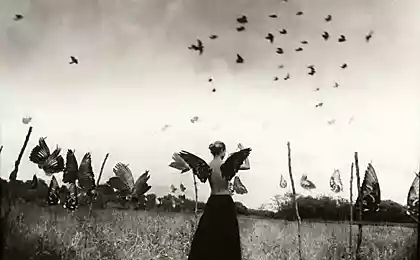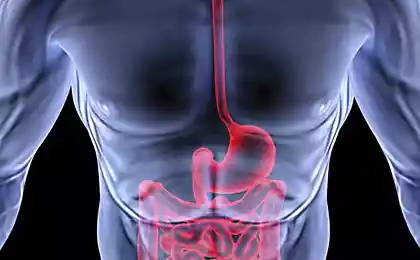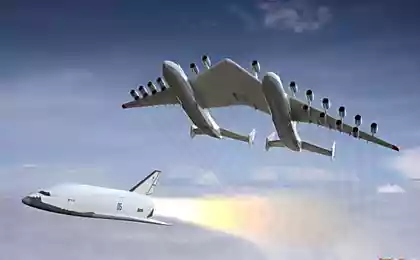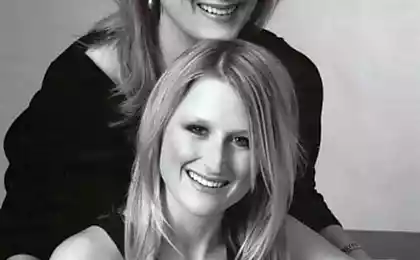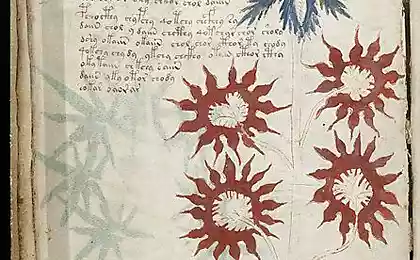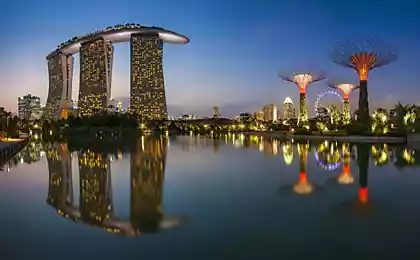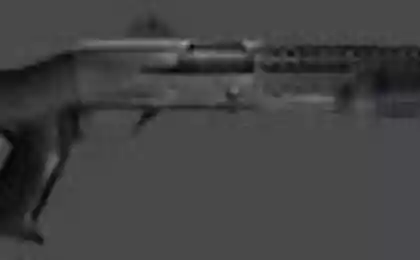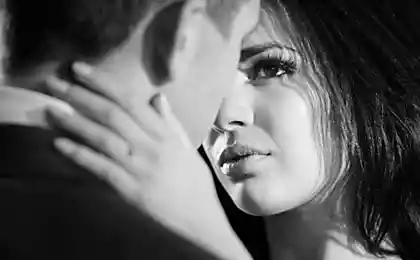989
Unrealized variants of the T-34
Everyone knows the banal phrase that history does not like subjunctive. But sometimes I want to simulate its course by entering into the already well-known formula to all the new term. Let not the reader will think reading the title of the article that the author tried to be as a prophet. His task was to tell you about the shape of the Soviet medium tank, the work on the creation of which took place in the winter and spring of 1941 and which had the opportunity to meet German "Panzerwaffe" They invade the Soviet Union did not in June 1941, and six months later. The story is based on actual documents and therefore can not be classified as a "non-scientific fiction».
Few historical characters +20 pictures via forum.worldoftanks.ru
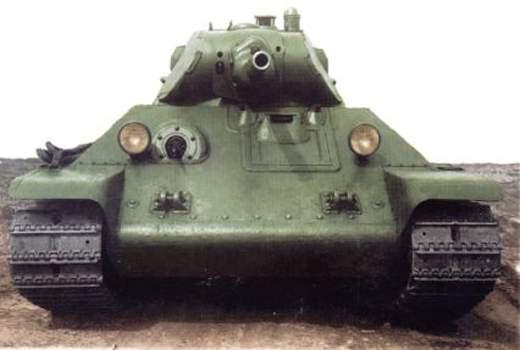
Tanks A-8, A-20, T-34 (mod. 1940.), T-34 (obr.1941g.)
The T-34 was adopted by Resolution of the Government of December 19, 1939 to manufacture prototypes. The first experimental tanks were manufactured in January 1940 and during the tests fully confirmed the high technical and fighting qualities.
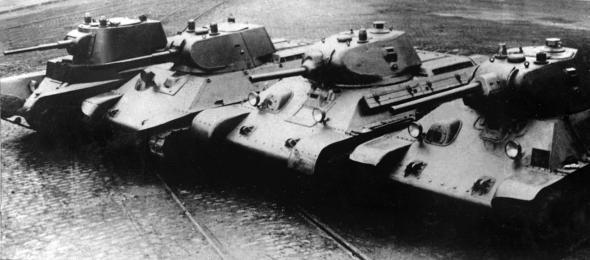
In March 1940 two T-34 tanks made a run to Moscow and back, showing thus high reliability of all components. This run was directly involved, MI Cat.
Serial production of T-34 tanks began in June 1940 and the end of the year, 115 cars were produced.
In June 1940 the government adopted a decision on deploying the production of T-34 tanks at other large enterprises of the country. In this regard, the design bureau of the plant №183 was urgently made complete sets of drawings and technical documentation of the T-34 and sent in the required quantities to the Stalingrad Tractor and Sormovo Shipyard.
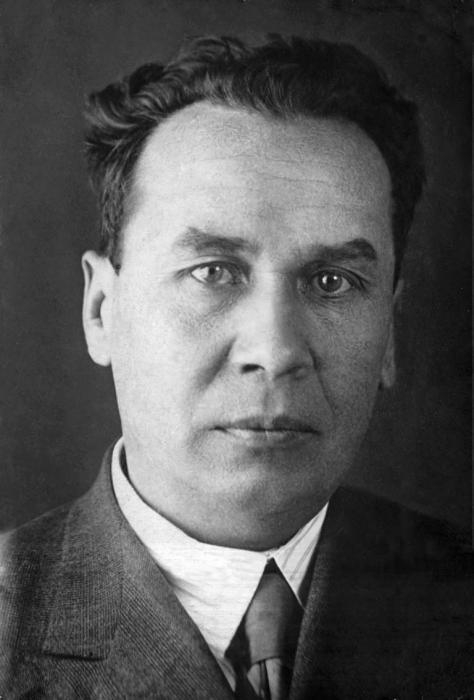
Series production of T-34 tanks, which was the final stage of the three-year hard work of designers and the entire staff of the factory, almost coincided with bereavement. After a long illness, September 26, 1940, died MI Cat. His premature death was a severe loss for the designers and factory. Chief Designer of the Tank Design Bureau was appointed as a student and associate of MI Koshkin - AA Morozov.

It seemed that the Red Army was, the same military machine that she needed desperately, but conducted in April-September 1940 military tests of two prototypes of the A-34 and the first two series of T-34 made under the new program, approved in October 1939 It was revealed at the series of tanks as shortcomings that their military value was called into question. It seemed that they did not have any node that during testing would not break.
Add fuel to the fire and spent the summer and autumn of 1940 (in August, October and November) Joint Test series T-34 and the two German tanks PzKpfw III, purchased in Germany in 1939 (another PzKpfw III was stolen from no man's land from under the noses of the German forces during the Polish campaign). Many authors claim that these tests resulted in the complete triumph of the Soviet machine, but it is not so. Of course, the arming and booking our tank was more successful, but ...
Tests of the first T-34 on the Karelian Isthmus. 1940
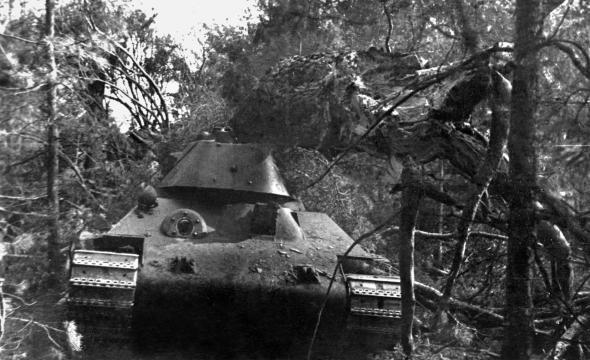
In the tower T-34 barely accommodated two tanker, one of which functions as a tank commander and commander of the gun, and in some cases also the commander of the unit. In the same German tank tower without problems placed three crew members, each of which had its own evacuation hatch. Tank commander had also convenient turret round view, and all crew members were supplied with the device's own internal communications (T-34 issues in 1940 intercom united only two tank - the commander and driver). Better proved a German car and ride it much less make a noise (at full speed on a gravel highway T-34 was heard at a distance of 400-500 m and more). A complete surprise to the Soviet military was the fact that one of the German tanks on the gravel highway (on the stretch Kubinka - Rechitsa) dispersed on dimensional kilometer up to speed 69, 7 km / h, while the best indicator for the T-34 was 48, 2 km / h, and highlighted as a standard BT-7 RV was only able to approach the Germans, showing a 68, 1 km / h. The Commission, chaired by Kulchytsky, said a successful German tank suspension, good quality optical instruments, comfortable accommodation ammunition and radio stations, the presence of the commander's turret, good quality engine and transmission.
Throwing on the engine hatch of the tank bottles with burning petrol
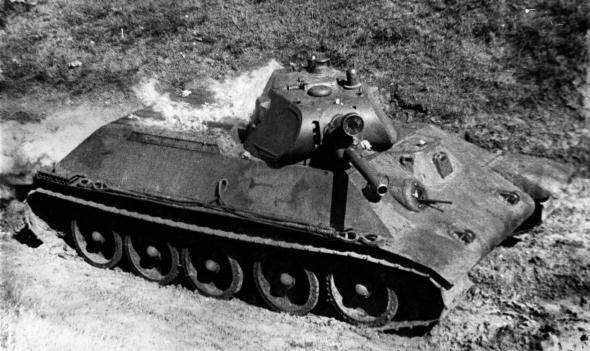
The layout of a medium tank T-34 of the sample in 1940
Tank A-41
The first project of the modernization of the T-34 was carried out by OKB-24 in the summer (the start of work in July) 1940. It had a factory index A-41. Formally, the supervisor of it was apparently still seriously ill GM Koshkin. All correspondence NaCSA (and NKTP) The first mention of the A-41 meets on September 12 when summed up the interim results. Tank A-41 (T-34 improved) is a development of the T-34 "second prototype" (apparently meant installing observation towers of the driver in the front part of the body). From the prototype tank differed triple pressed tower in pursuit of a diameter of 1700 mm, which was to be found a 76-mm long-barreled gun, ordered the OKB number 92 (referring to an instrument of F-34) instead of diesel V-2 MTO new tank should It was to stay with a diesel engine M-250. But the body and chassis were to remain unchanged. It was assumed that a large three-tower with an observation turret again will remove most of the problems with the tank's visibility and comfort inside; simplify the management of the tank in combat.
Among other improvements to the machine to be installed in its new six-speed transmission with strengthened main clutch, as well as to increase by 60-80 l. fuel capacity and provide for the possibility of setting in place a course of action pneumatic gun flamethrower (the experience of the Soviet-Finnish soldiers).
Judging by the help Malyshev, A-41 project was completed on 15 October. A 1 November, it was decided to cease work on it as prototyping Commission questioned the parameters of the project according to the requirements of the TOR (to install on an existing tower with a range of housing services 1700 mm without altering the body was deemed impossible). It is also unrealistic to recognize the possibility of manufacturing the deadline fundamentally new gearbox, rejected design tselnoshtampovannyh towers.
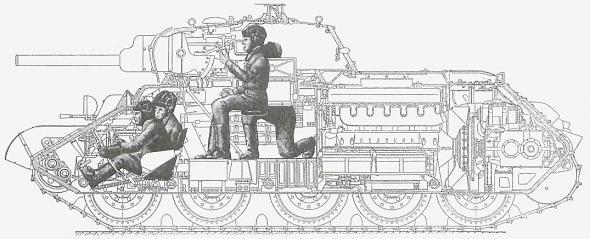
Tank A-43 (T-34M)
According to the orders of Defence Committee at SNK dated October 7, in KB KhPZ autumn turned the work on the T-34 tank modernization of the capital. This tank factory index was A-43 and is a kind of hybrid of T-34 and the German PzKpfw III. When the project's designers had hoped to kill with one blow all claims of war and therefore tried to please him in everything. The new A-43 was to be a little longer (taking into account a longer gun barrel F-34), narrower and higher than T-34 and its clearance was increased to 50 mm for facilitating the movement of the snow. Especially for this tank was designed version of the diesel engine B-5 output of 600 hp In order not to spend a lot of time to create a new checkpoint on the new tank to improve its dynamic performance, set the old one, expanding it splitter. Thus, A-43 was able to movement with 8-speed "forward" and two "back". Candle suspension type Christie's gave way to the individual torsion, a well-established German PzKpfw III and national QMS and HF. At 140 liters. It has increased the volume of fuel tanks.
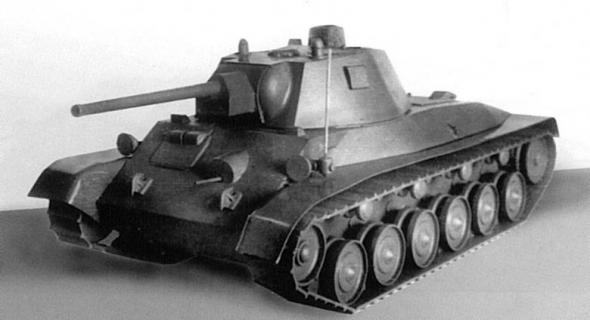
To improve the habitability of the tank it was recomposed. The driver of the tank (the beginning to combine the duties of a mechanic) has removed it from the left side of the driver's compartment to the right, respectively, the shooter (who is now a radio operator) took a seat to his left. The tank was three-man turret with epaulets 1700 mm, which demanded the military, equipped to the same observation turret with a concealed observation devices. Since the construction of the tower has been carefully designed for the A-41, A-43, it did not raise any questions. In order to improve the placement of ammunition from the radio tower was moved into the body of the tank closer to the arrow-radio operator. It has allowed to increase a little ammunition guns and machine guns. For the first time in the history of the domestic tank production of the standard weapons of the tank was introduced PPD submachine gun and machine gun instead of a course provided for the possibility of installing pneumatic or gunpowder flamethrower.
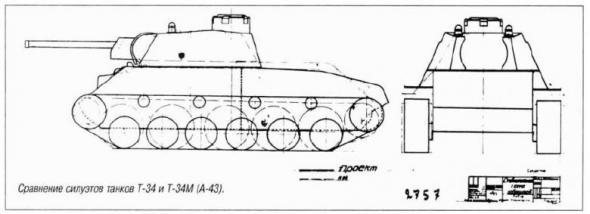
Despite all these "supplements" while maintaining the same thickness of armor was on the 987 kg lighter than the T-34, and therefore (in the application of the new engine and the two PPC) its speed was increased from 50 to 53-56 km / h, but slightly increased It is also ground pressure since the caterpillars have been narrowed by 100 mm (up to 450-460 mm).
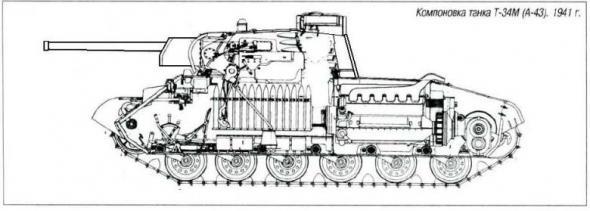
The project seemed so good that in February 1941 it was approved by KO in the CPC and the CPSU (b), which received an order for the manufacture of wooden models in 1:10 scale and full-size. The meeting mock-up committee did not bring any surprises. The only improvements that recommended the "higher authorities" was to increase the thickness of the frontal armor of the tank to 60 mm (with the possibility of further increasing it to 75 mm) as a reserve mass nearly one ton of easily allows you to do. In March, it began production of two standard samples of the tank, which was named for privacy T-34M. At the same time allied started to develop serial production of the tank units. The first of subcontractors to design mode left the factory number 92 of the IEC, which was March 1, 1941 began shipping the guns F-34 for the A-43 and for standing in the series of T-34.
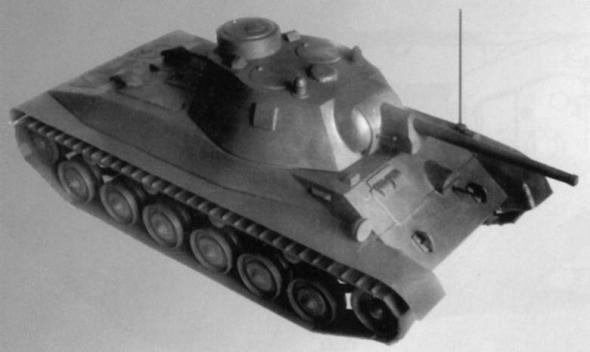
Under the leadership of Chief Metallurgist Mariupol plant them. Illich - V.Nitsenko for the A-43 was designed "stamped-welded tower" and in May 1941 the plant produced not only the first 5 pcs., But also prepared them for serial production. By 17 May, it was also completed production of three buildings of the new tank.
Torsion bars, skating rinks, and several other elements of the chassis for the six sets of tanks were submitted to the April 21 Kharkiv Tractor Plant. It seemed a little tank and finally see the light, but the sticking point for him was the engine B-5, which has not been delivered or by May 1 or June 15 or to the 25 July 1941
During the evacuation of the plant number 183 from Kharkov in Nizhny Tagil went 5 complete (fully assembled with weapons) towers, manned by two hulls with the suspension, but without engines, three unmanned housing, as well as three additional sets of spare parts. Mariupol, the plant has taken out 50 (or 46) is nearly completed towers.
But the work was not pursued tank. A-43 died, and not being able to be born.

During the evacuation of the plant number 183 from Kharkov in Nizhny Tagil went 5 complete (fully assembled with weapons) towers, manned by two hulls with the suspension, but without engines, three unmanned housing, as well as three additional sets of spare parts. Mariupol, the plant has taken out 50 (or 46) is nearly completed towers.
But the work was not pursued tank. A-43 died, and not being able to be born.
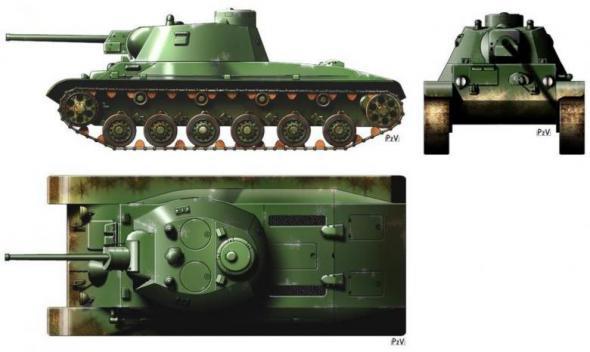
Tank A-44
During the work on the modernization of the T-34 CB plant number 183 (Kharkiv) under the leadership of Morozov in March 1941 study conducted constructive projects tank A-44 with different variants of the basic weapons and more powerful armor. The annex to the order NaCSA number 192 of May 10, 1941 (in accordance with the Decision of the CPC of the USSR and the CPSU (b) of 5 May 1941), "On the production of T-34 tanks in 1941" were determined on the tank TTT A-44, according to which he should have had a combat weight of 29-29, 5 tons, armor protection body: frontal armor of 75 mm at an angle of 60 & quot ;, board - 60 mm feed - 55 mm at an angle of 35 & quot; -45 & quot ;, the bottom - 20-25 mm, the roof - 30 ° mm tower forehead - 75 mm at an angle of 25 °, feed 75 mm at an angle of 15 °, Reservation artillery system - 60 mm.
As the main weapon was supposed to establish 76 2-mm gun ZIS-5 or 57-mm gun ZIS-4, coupled with two machine-guns, auxiliary - two coaxial machine gun DT in the frontal part of the body. Instead of machine-guns in the front of the chassis also provides for installation of a flame-thrower stock ognesmesi 10-15 shots. In the ammunition tanks with the radio station were 100 rounds for the gun and 6,000 rounds of ammunition for machine guns DT to flamethrower tanks - 90 rounds of ammunition and 4,500 respectively. For aimed fire use a periscope (PT) and telescopic (TOD) sights.
The tank is provided for the installation of a diesel engine output of 600 hp (441 kW 2) provides a maximum speed of 55-60 km / h. Fuel capacity of 600 liters. The structure was part of caterpillar tracks individual torsion bar suspension, support and support rollers with internal shock absorbers, caterpillar lantern meshing. In order to establish radio communication with KRSTB TPU-3 and light-signaling between the tank commander and driver.
The same order number 183 factory ordered "by 15 October 1941 to produce two prototypes of the tank A-44, 1 September 1941 - the two sets bronedetaley in November 1941 to test the A-44 to November 25, 1941 the test results for the present report to the Committee of Defence. "

Perhaps the idea of creating a new unusual tank emerged from its author when he analyzed the results of the shelling of the prototype T-34 of the PTA from all sides. In conclusion, the results of firing T-34 Morozov particularly noted: "The least dangerous in the shelling of the T-34 is its rear angles. Even in the case of penetration of armor is the tank can be damaged just by the destruction of the engine or transmission units ... In case of fire engine crew leaves the vehicle suffered no ... »
Elaborate projects of different variants of A-44 tank (instead of two have been worked out three possible settings for the main armament and armor protection) from the production of wooden models of cars it has been approved by the Marshal of the Soviet Union Kliment Voroshilov. During the design work in connection with the installation of more powerful weapons and armor protection defined TTT combat weight machine has been exceeded, with the result that, according to the then current classification, they have come under the category of heavy tanks. Layout scheme of the project included the A-44 aft of the crew compartment. In front of the building has departments: transmission, control and motor. The forward part of the left branch control each other housed a driver and a gunner. At the rear of the hull and the tower housed the fighting compartment, which houses: the left of the gun - the gunner behind him - the commander, right - loader. To observe the battlefield on the roof of the tower was installed a rotating commander's cupola, which houses the private twin anti-aircraft machine guns DT installation. Embarkation and disembarkation of the crew carried out through the hatch of the driver and radio operator located in the roof of the building and the two towers of the sunroof. Commander's turret hatch had no input in its roof hatch was only for signaling. It was developed three variants of the machines that you install different weapons and armor protection.
As the main weapon in the tank can be installed 57-mm tank gun ZIS-4, 76, 2-mm tank gun ZIS-5 or a 107-mm gun ZIS-6 (!) Paired with two machine guns DT. The auxiliary equipment except in the twin anti-aircraft commander's cupola, used two paired installation machine-guns in the front part of the body from the radio operator-gunner in the turret. Ammunition car consisted of 160 shots, respectively, to 57 or 76 mm, 2-mm gun, 60 rounds for 107-mm gun and 2600 rounds of ammunition for machine guns DT. For firing sights used TOD and PT-7. For removal of powder gases from the crew compartment in the roof of the tower was installed exhaust fan.
The armor protection - protivosnaryadnym. Welded hull and turret, made of rolled armor plates, depending on the set of arms have a thickness of the frontal armor, respectively 75, 90 and 120 mm. The angle of the armor plates was 60 & quot; housing and 25 ° - for the tower. The thickness of the armor sides being respectively equal to 60, 75 and 100 mm, and roof and floor - 30, 35 and 40 mm. Weight machines are respectively 36, 40 and 50 tons.
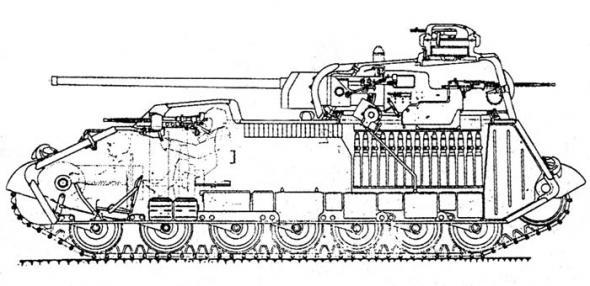
In the nose of the car was supposed to install a mechanical transmission consisting of multi-disc main clutch dry friction, mechanical transmission provides 6 speed forward and 1 reverse gear, two multi-disc steering clutches dry friction belt brakes with pads from Ferodo, and two single-stage final drive. In the middle of the hull along its longitudinal axis, depending on the mass of the machine may be installed in diesel-5 output of 600 hp (441 kW) or B-6 850 hp (625 kW) with support systems.
Suspension tank - individual, torsion. The caterpillar tracks used 8 and 14 supporting the small-diameter road wheels with internal shock absorption.
))
Source:
Few historical characters +20 pictures via forum.worldoftanks.ru

Tanks A-8, A-20, T-34 (mod. 1940.), T-34 (obr.1941g.)
The T-34 was adopted by Resolution of the Government of December 19, 1939 to manufacture prototypes. The first experimental tanks were manufactured in January 1940 and during the tests fully confirmed the high technical and fighting qualities.

In March 1940 two T-34 tanks made a run to Moscow and back, showing thus high reliability of all components. This run was directly involved, MI Cat.
Serial production of T-34 tanks began in June 1940 and the end of the year, 115 cars were produced.
In June 1940 the government adopted a decision on deploying the production of T-34 tanks at other large enterprises of the country. In this regard, the design bureau of the plant №183 was urgently made complete sets of drawings and technical documentation of the T-34 and sent in the required quantities to the Stalingrad Tractor and Sormovo Shipyard.

Series production of T-34 tanks, which was the final stage of the three-year hard work of designers and the entire staff of the factory, almost coincided with bereavement. After a long illness, September 26, 1940, died MI Cat. His premature death was a severe loss for the designers and factory. Chief Designer of the Tank Design Bureau was appointed as a student and associate of MI Koshkin - AA Morozov.

It seemed that the Red Army was, the same military machine that she needed desperately, but conducted in April-September 1940 military tests of two prototypes of the A-34 and the first two series of T-34 made under the new program, approved in October 1939 It was revealed at the series of tanks as shortcomings that their military value was called into question. It seemed that they did not have any node that during testing would not break.
Add fuel to the fire and spent the summer and autumn of 1940 (in August, October and November) Joint Test series T-34 and the two German tanks PzKpfw III, purchased in Germany in 1939 (another PzKpfw III was stolen from no man's land from under the noses of the German forces during the Polish campaign). Many authors claim that these tests resulted in the complete triumph of the Soviet machine, but it is not so. Of course, the arming and booking our tank was more successful, but ...
Tests of the first T-34 on the Karelian Isthmus. 1940

In the tower T-34 barely accommodated two tanker, one of which functions as a tank commander and commander of the gun, and in some cases also the commander of the unit. In the same German tank tower without problems placed three crew members, each of which had its own evacuation hatch. Tank commander had also convenient turret round view, and all crew members were supplied with the device's own internal communications (T-34 issues in 1940 intercom united only two tank - the commander and driver). Better proved a German car and ride it much less make a noise (at full speed on a gravel highway T-34 was heard at a distance of 400-500 m and more). A complete surprise to the Soviet military was the fact that one of the German tanks on the gravel highway (on the stretch Kubinka - Rechitsa) dispersed on dimensional kilometer up to speed 69, 7 km / h, while the best indicator for the T-34 was 48, 2 km / h, and highlighted as a standard BT-7 RV was only able to approach the Germans, showing a 68, 1 km / h. The Commission, chaired by Kulchytsky, said a successful German tank suspension, good quality optical instruments, comfortable accommodation ammunition and radio stations, the presence of the commander's turret, good quality engine and transmission.
Throwing on the engine hatch of the tank bottles with burning petrol

The layout of a medium tank T-34 of the sample in 1940
Tank A-41
The first project of the modernization of the T-34 was carried out by OKB-24 in the summer (the start of work in July) 1940. It had a factory index A-41. Formally, the supervisor of it was apparently still seriously ill GM Koshkin. All correspondence NaCSA (and NKTP) The first mention of the A-41 meets on September 12 when summed up the interim results. Tank A-41 (T-34 improved) is a development of the T-34 "second prototype" (apparently meant installing observation towers of the driver in the front part of the body). From the prototype tank differed triple pressed tower in pursuit of a diameter of 1700 mm, which was to be found a 76-mm long-barreled gun, ordered the OKB number 92 (referring to an instrument of F-34) instead of diesel V-2 MTO new tank should It was to stay with a diesel engine M-250. But the body and chassis were to remain unchanged. It was assumed that a large three-tower with an observation turret again will remove most of the problems with the tank's visibility and comfort inside; simplify the management of the tank in combat.
Among other improvements to the machine to be installed in its new six-speed transmission with strengthened main clutch, as well as to increase by 60-80 l. fuel capacity and provide for the possibility of setting in place a course of action pneumatic gun flamethrower (the experience of the Soviet-Finnish soldiers).
Judging by the help Malyshev, A-41 project was completed on 15 October. A 1 November, it was decided to cease work on it as prototyping Commission questioned the parameters of the project according to the requirements of the TOR (to install on an existing tower with a range of housing services 1700 mm without altering the body was deemed impossible). It is also unrealistic to recognize the possibility of manufacturing the deadline fundamentally new gearbox, rejected design tselnoshtampovannyh towers.

Tank A-43 (T-34M)
According to the orders of Defence Committee at SNK dated October 7, in KB KhPZ autumn turned the work on the T-34 tank modernization of the capital. This tank factory index was A-43 and is a kind of hybrid of T-34 and the German PzKpfw III. When the project's designers had hoped to kill with one blow all claims of war and therefore tried to please him in everything. The new A-43 was to be a little longer (taking into account a longer gun barrel F-34), narrower and higher than T-34 and its clearance was increased to 50 mm for facilitating the movement of the snow. Especially for this tank was designed version of the diesel engine B-5 output of 600 hp In order not to spend a lot of time to create a new checkpoint on the new tank to improve its dynamic performance, set the old one, expanding it splitter. Thus, A-43 was able to movement with 8-speed "forward" and two "back". Candle suspension type Christie's gave way to the individual torsion, a well-established German PzKpfw III and national QMS and HF. At 140 liters. It has increased the volume of fuel tanks.

To improve the habitability of the tank it was recomposed. The driver of the tank (the beginning to combine the duties of a mechanic) has removed it from the left side of the driver's compartment to the right, respectively, the shooter (who is now a radio operator) took a seat to his left. The tank was three-man turret with epaulets 1700 mm, which demanded the military, equipped to the same observation turret with a concealed observation devices. Since the construction of the tower has been carefully designed for the A-41, A-43, it did not raise any questions. In order to improve the placement of ammunition from the radio tower was moved into the body of the tank closer to the arrow-radio operator. It has allowed to increase a little ammunition guns and machine guns. For the first time in the history of the domestic tank production of the standard weapons of the tank was introduced PPD submachine gun and machine gun instead of a course provided for the possibility of installing pneumatic or gunpowder flamethrower.

Despite all these "supplements" while maintaining the same thickness of armor was on the 987 kg lighter than the T-34, and therefore (in the application of the new engine and the two PPC) its speed was increased from 50 to 53-56 km / h, but slightly increased It is also ground pressure since the caterpillars have been narrowed by 100 mm (up to 450-460 mm).

The project seemed so good that in February 1941 it was approved by KO in the CPC and the CPSU (b), which received an order for the manufacture of wooden models in 1:10 scale and full-size. The meeting mock-up committee did not bring any surprises. The only improvements that recommended the "higher authorities" was to increase the thickness of the frontal armor of the tank to 60 mm (with the possibility of further increasing it to 75 mm) as a reserve mass nearly one ton of easily allows you to do. In March, it began production of two standard samples of the tank, which was named for privacy T-34M. At the same time allied started to develop serial production of the tank units. The first of subcontractors to design mode left the factory number 92 of the IEC, which was March 1, 1941 began shipping the guns F-34 for the A-43 and for standing in the series of T-34.

Under the leadership of Chief Metallurgist Mariupol plant them. Illich - V.Nitsenko for the A-43 was designed "stamped-welded tower" and in May 1941 the plant produced not only the first 5 pcs., But also prepared them for serial production. By 17 May, it was also completed production of three buildings of the new tank.
Torsion bars, skating rinks, and several other elements of the chassis for the six sets of tanks were submitted to the April 21 Kharkiv Tractor Plant. It seemed a little tank and finally see the light, but the sticking point for him was the engine B-5, which has not been delivered or by May 1 or June 15 or to the 25 July 1941
During the evacuation of the plant number 183 from Kharkov in Nizhny Tagil went 5 complete (fully assembled with weapons) towers, manned by two hulls with the suspension, but without engines, three unmanned housing, as well as three additional sets of spare parts. Mariupol, the plant has taken out 50 (or 46) is nearly completed towers.
But the work was not pursued tank. A-43 died, and not being able to be born.

During the evacuation of the plant number 183 from Kharkov in Nizhny Tagil went 5 complete (fully assembled with weapons) towers, manned by two hulls with the suspension, but without engines, three unmanned housing, as well as three additional sets of spare parts. Mariupol, the plant has taken out 50 (or 46) is nearly completed towers.
But the work was not pursued tank. A-43 died, and not being able to be born.

Tank A-44
During the work on the modernization of the T-34 CB plant number 183 (Kharkiv) under the leadership of Morozov in March 1941 study conducted constructive projects tank A-44 with different variants of the basic weapons and more powerful armor. The annex to the order NaCSA number 192 of May 10, 1941 (in accordance with the Decision of the CPC of the USSR and the CPSU (b) of 5 May 1941), "On the production of T-34 tanks in 1941" were determined on the tank TTT A-44, according to which he should have had a combat weight of 29-29, 5 tons, armor protection body: frontal armor of 75 mm at an angle of 60 & quot ;, board - 60 mm feed - 55 mm at an angle of 35 & quot; -45 & quot ;, the bottom - 20-25 mm, the roof - 30 ° mm tower forehead - 75 mm at an angle of 25 °, feed 75 mm at an angle of 15 °, Reservation artillery system - 60 mm.
As the main weapon was supposed to establish 76 2-mm gun ZIS-5 or 57-mm gun ZIS-4, coupled with two machine-guns, auxiliary - two coaxial machine gun DT in the frontal part of the body. Instead of machine-guns in the front of the chassis also provides for installation of a flame-thrower stock ognesmesi 10-15 shots. In the ammunition tanks with the radio station were 100 rounds for the gun and 6,000 rounds of ammunition for machine guns DT to flamethrower tanks - 90 rounds of ammunition and 4,500 respectively. For aimed fire use a periscope (PT) and telescopic (TOD) sights.
The tank is provided for the installation of a diesel engine output of 600 hp (441 kW 2) provides a maximum speed of 55-60 km / h. Fuel capacity of 600 liters. The structure was part of caterpillar tracks individual torsion bar suspension, support and support rollers with internal shock absorbers, caterpillar lantern meshing. In order to establish radio communication with KRSTB TPU-3 and light-signaling between the tank commander and driver.
The same order number 183 factory ordered "by 15 October 1941 to produce two prototypes of the tank A-44, 1 September 1941 - the two sets bronedetaley in November 1941 to test the A-44 to November 25, 1941 the test results for the present report to the Committee of Defence. "

Perhaps the idea of creating a new unusual tank emerged from its author when he analyzed the results of the shelling of the prototype T-34 of the PTA from all sides. In conclusion, the results of firing T-34 Morozov particularly noted: "The least dangerous in the shelling of the T-34 is its rear angles. Even in the case of penetration of armor is the tank can be damaged just by the destruction of the engine or transmission units ... In case of fire engine crew leaves the vehicle suffered no ... »
Elaborate projects of different variants of A-44 tank (instead of two have been worked out three possible settings for the main armament and armor protection) from the production of wooden models of cars it has been approved by the Marshal of the Soviet Union Kliment Voroshilov. During the design work in connection with the installation of more powerful weapons and armor protection defined TTT combat weight machine has been exceeded, with the result that, according to the then current classification, they have come under the category of heavy tanks. Layout scheme of the project included the A-44 aft of the crew compartment. In front of the building has departments: transmission, control and motor. The forward part of the left branch control each other housed a driver and a gunner. At the rear of the hull and the tower housed the fighting compartment, which houses: the left of the gun - the gunner behind him - the commander, right - loader. To observe the battlefield on the roof of the tower was installed a rotating commander's cupola, which houses the private twin anti-aircraft machine guns DT installation. Embarkation and disembarkation of the crew carried out through the hatch of the driver and radio operator located in the roof of the building and the two towers of the sunroof. Commander's turret hatch had no input in its roof hatch was only for signaling. It was developed three variants of the machines that you install different weapons and armor protection.
As the main weapon in the tank can be installed 57-mm tank gun ZIS-4, 76, 2-mm tank gun ZIS-5 or a 107-mm gun ZIS-6 (!) Paired with two machine guns DT. The auxiliary equipment except in the twin anti-aircraft commander's cupola, used two paired installation machine-guns in the front part of the body from the radio operator-gunner in the turret. Ammunition car consisted of 160 shots, respectively, to 57 or 76 mm, 2-mm gun, 60 rounds for 107-mm gun and 2600 rounds of ammunition for machine guns DT. For firing sights used TOD and PT-7. For removal of powder gases from the crew compartment in the roof of the tower was installed exhaust fan.
The armor protection - protivosnaryadnym. Welded hull and turret, made of rolled armor plates, depending on the set of arms have a thickness of the frontal armor, respectively 75, 90 and 120 mm. The angle of the armor plates was 60 & quot; housing and 25 ° - for the tower. The thickness of the armor sides being respectively equal to 60, 75 and 100 mm, and roof and floor - 30, 35 and 40 mm. Weight machines are respectively 36, 40 and 50 tons.

In the nose of the car was supposed to install a mechanical transmission consisting of multi-disc main clutch dry friction, mechanical transmission provides 6 speed forward and 1 reverse gear, two multi-disc steering clutches dry friction belt brakes with pads from Ferodo, and two single-stage final drive. In the middle of the hull along its longitudinal axis, depending on the mass of the machine may be installed in diesel-5 output of 600 hp (441 kW) or B-6 850 hp (625 kW) with support systems.
Suspension tank - individual, torsion. The caterpillar tracks used 8 and 14 supporting the small-diameter road wheels with internal shock absorption.
))
Source:




